Advertisement
In Dorchester, 'Altarations' Provides A Whole New View Of The Sacred
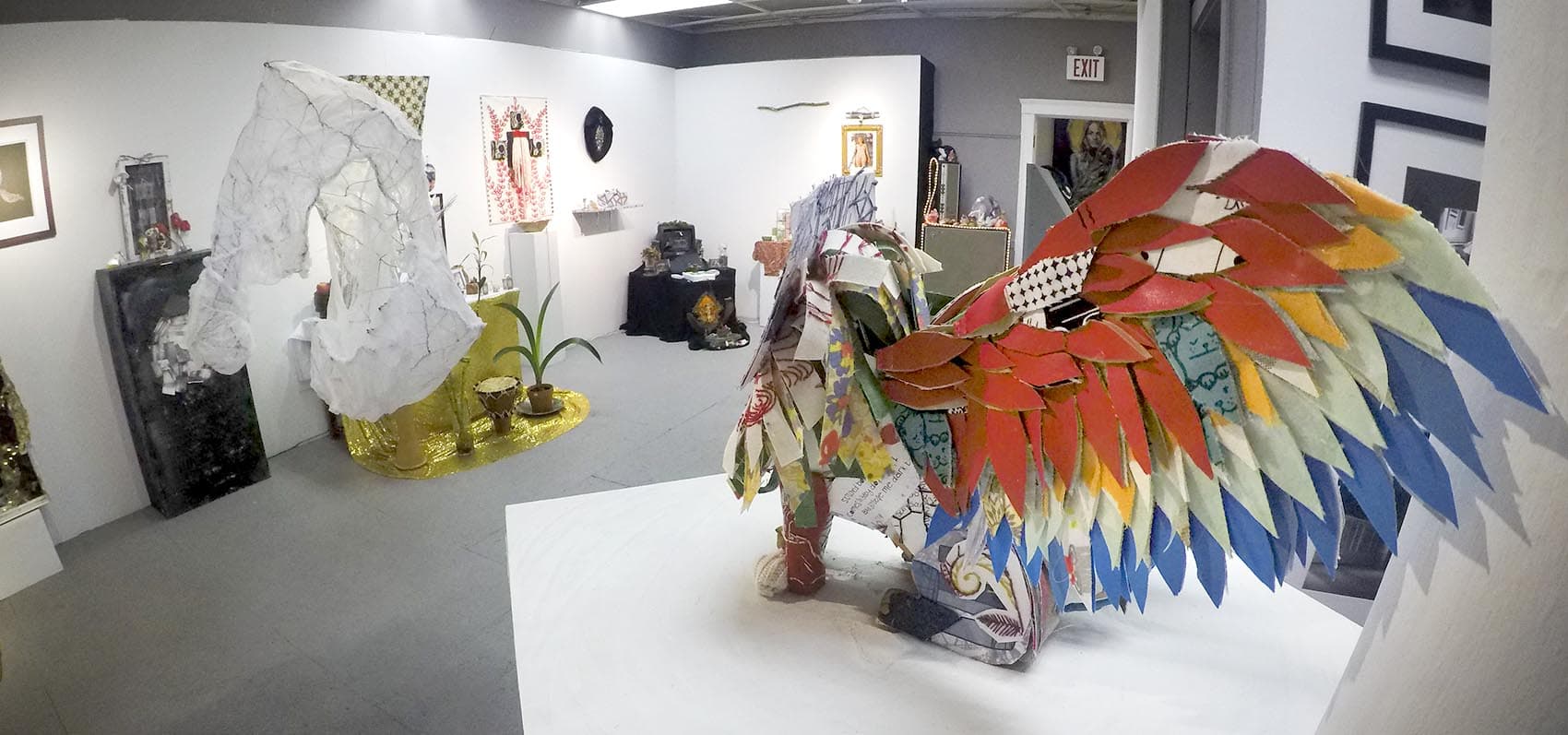
The beautifully arranged remnants of failed art projects. A corner given over to photos of a deceased loved one. A group of religious figurines painted and adorned in a riot of electric colors. Even a cabinet of modeled genitalia curios. Here in America, as impertinent and ill-bred as we are, a shrine can be most anything you want to make it.
And that’s part of the point of “Altarations: A Selection of Shrines” opening July 21 at the Dorchester Art Project. In that other sacred space called the art gallery, the show is an intriguing exploration of the great width and breadth of what each of us holds dear. As a society, we may lack the kind of social and religious cohesion found elsewhere around the globe, but we’re working overtime to fill in the blanks.
“We often inherit our sense of spirituality from family or however we grow up,” says Emma Leavitt, gallery manager at Dorchester Art Project (DAP) and co-curator of the show along with gallery director Sophia Giordano. “And then it often becomes filtered through time and space and through our own experience into something different. That's where the name is tied in -- 'Altarations' -- we inherit the way that we worship but then we have to change it to fit our own lived experience. It's something that every human does. It’s really interesting to see all the interpretations of that in one room.”
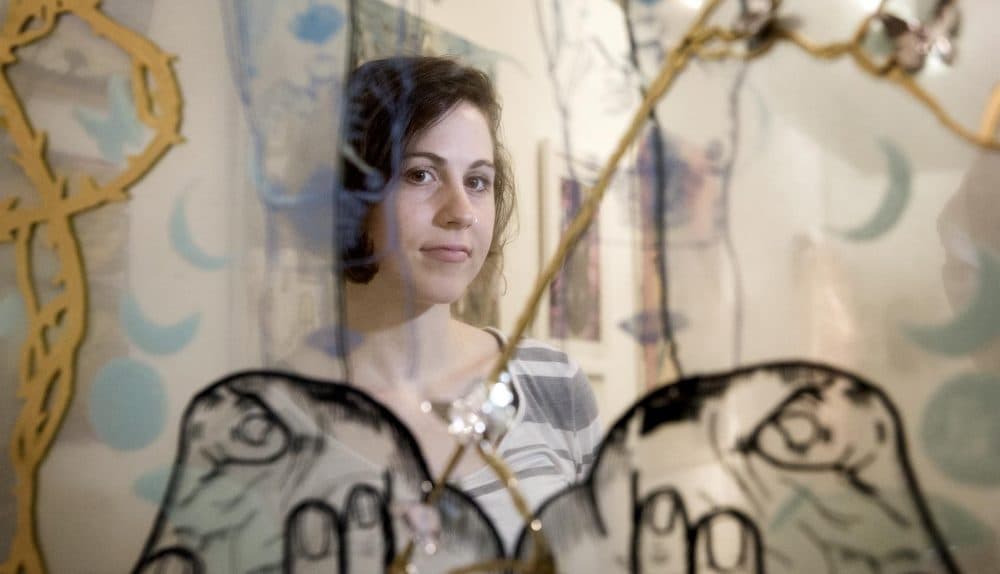
In fact, we find 60 interpretations of the hallowed and revered (80 shrines in all) in DAP’s three galleries, even spilling out into the space’s front hallway -- from video installations of sacred rites to surrealist paintings plumbing the dark depths of the subconscious, to far lighter tributes to TV characters like Morticia Addams of "The Addams Family" and Endora of "Bewitched" fame. Some of these shrines were the creation of artists, others the loving conception of otherwise regular folk who have discovered spiritual meaning in places you might not necessarily expect it. (Even former ARTery scribe and artist Greg Cook gets in on the action with his “The Enchanted Forest” shrine, a memorial to the trees felled by climate change.)
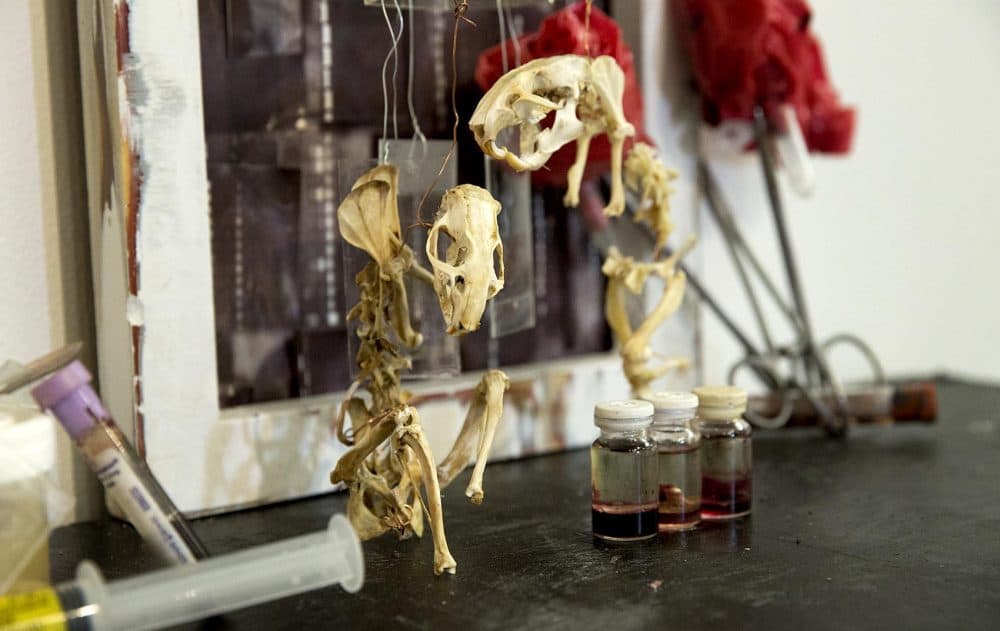
And so, we have diversity and lots of it. Scientist and artist Anna Rock’s shrine “With Each of You, a Part of Me” is dedicated to the lowly lab rat. It features the skeletons of two of her pet rats (one came from the lab of a friend) meticulously arranged underneath a dangling chandelier of glass slides holding cross sections of monkey brains. Surgical tools surround the tiny skeletons, along with a bouquet of flowers of biohazard bags with centrifuge tubes perched atop hemostat stems. Behind it all is a window pane of genetic sequencing output imagery. Lava lamps with Rock’s own blood function as commemorative candles.
The skeletons are enticing and elegant, says Rock, “until the viewer recognizes the species, which has been long considered a plague-ridden and worthless creature.”
“My shrine memorializes the death of my career in academic neuroscience research,” she says. “During my eight years studying the brain in research animals, I felt increasingly distressed by the lives I sacrificed to science.”
Advertisement
She was particularly devastated, she says, by her research using Macaque monkeys at an MIT lab. By the end, she was so despondent she decided to quit neuroscience altogether. Lately, however, she’s come back around. She is thinking of pursuing a doctorate in neuroscience and biology, although she has resolved to do it differently -- this time, as an advocate for animals.
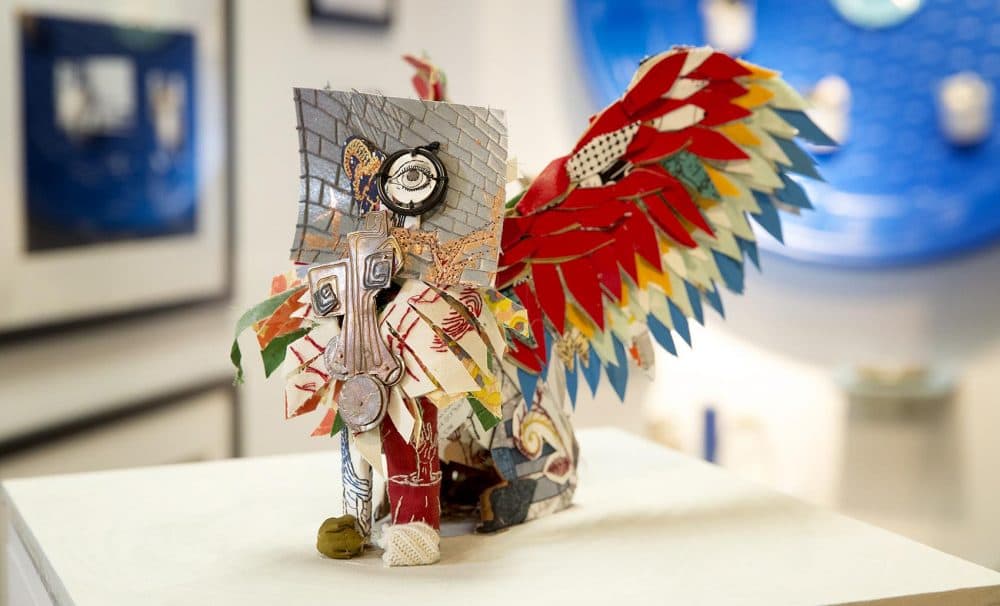
Or there is the shrine of Alexis Agbay, a milliner at Salmagundi in Jamaica Plain and former MassArt grad who has held an array of jobs in textiles, including as a textile conservationist and a custom clothing designer.
Her entry “Homage to Failure” was built “in honor of all my past failings.”
“It is all my past artwork that I have kept collaged into a sphinx-like creature. The sphinx was a story about a creature with a head of a woman, body of a lion and wings of an eagle that went around asking everyone the same riddle. Many people failed to answer and only one person succeeded. It represents the overpowering importance of the discarded journey.”
The discards of 10 years’ worth of left-over college projects, embroidery, illustrations and wallets she designed, were glued together into a raffish, Dada-esque sphinx with paws fashioned from fabric from a clothing line she designed in school.
“Failure rules most people’s lives and decisions,” she says. “People are often motivated by fear of failure, avoidance of past failures, or learning experiences caused by failures. If you think about how often people hope/pray to avoid failure it seems to be a god… One that people fear and definitely do not respect. I am at a point in my life where I am trying to view failure as an adventure and not something to be ashamed of.”
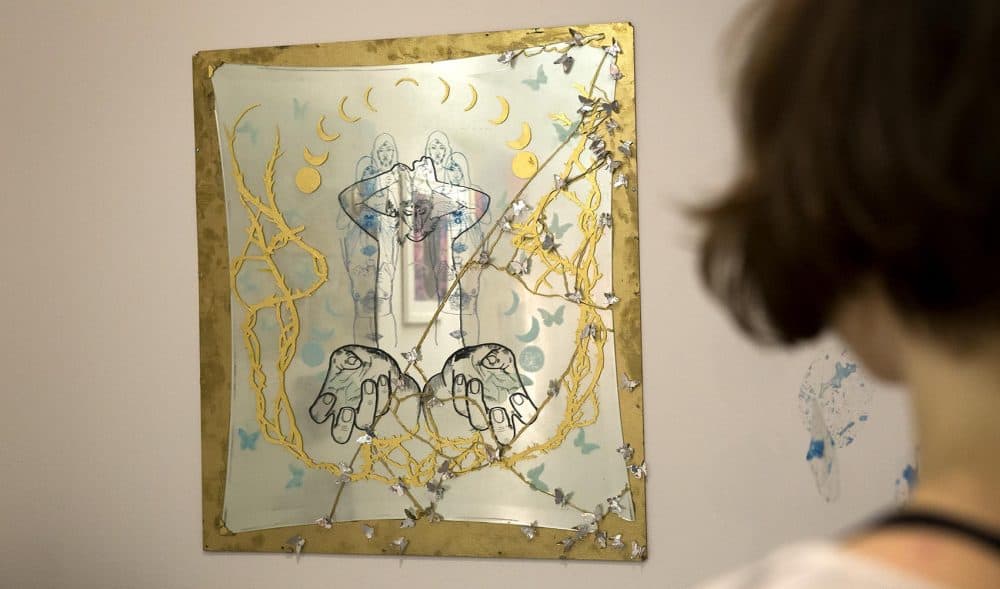
Carolina Laredo, on the other hand, considers her body a temple. A Latinx whose immigrant family hails from Peru, she is the first generation of her family to go to college. Her shrine “Insomnia” is a mixed media portrait of herself, incorporating a mirror, wood, Mylar, screenprint and 18 carat gold leaf. It depicts six female figures delicately rendered in light blue, behind one looming dark figure. The six figures represent Laredo’s many conflicting insecurities.
"My body is my temple but it doesn’t always feel that way," she says. "I face much anxiety every day when I look into the mirror -- facing PTSD, constant fear and the hardships of being a minority in an academic institution."
“Facing a mirror can be the most difficult thing when you are not in the right state of mind, especially as a woman who feels constant pressure from society about the way she looks. I designed my shrine on a mirror so the viewer can reflect on the anxiety and insomnia familiar to so many women. Another aspect of the mirror is that there are gilded cracks through the mirror representing myself as imperfect but still beautiful for being alive and thriving. The butterflies are a reflection of my immigrant family roots and display a struggle millions of people face as a minority.”
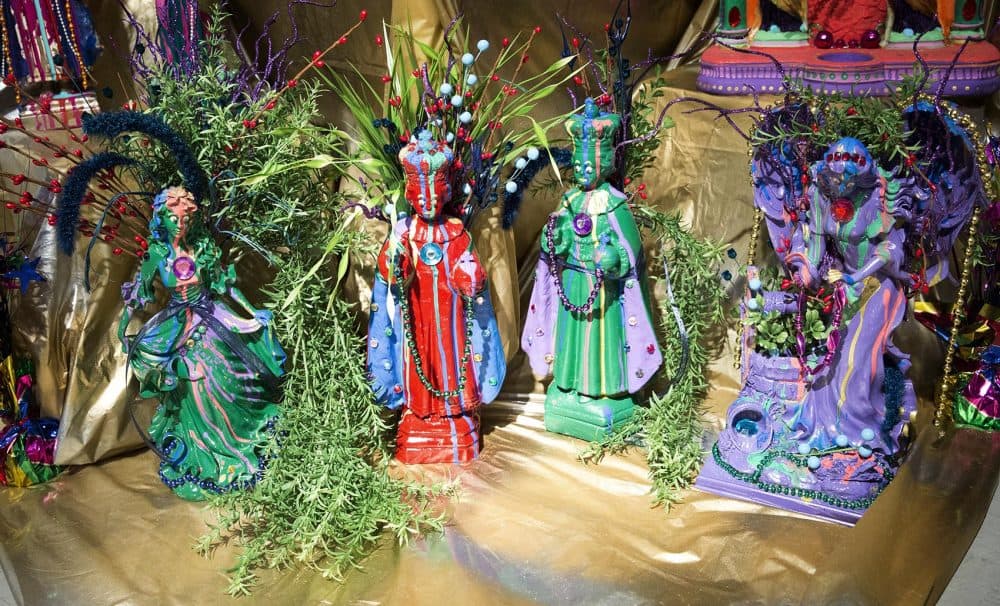
Alex Miklowski, a Polish-American artist and musician, presents some of the more colorful shrines, and in some ways, the more traditional. Indeed, according to Leavitt, Miklowski inspired the show since her art has long involved creating shrines out of thrifted or found figurines referencing Christian/Catholic imagery. Her preferred materials are cheap, plastic and brightly colored, and her works feature acrylic paint, Mardi Gras beads, jewels and fake flowers, recalling something of a Mexican folk art retablo.
Two of her 19 pieces in the show were created for friends. “Welcome to J.P.,” she says, was created for show curator Emma Leavitt when she moved to Jamaica Plain. The other was made for a different friend whom she credits with helping her move past a difficult time.
“I would say this shrine is a devotional to our friendship and its healing powers,” Miklowski says.
“My spirituality is very private and personal to me, so I resolve my anger and frustration with the organized religion I was raised with [Roman Catholicism] by turning these icons into my own shrines,” she says.
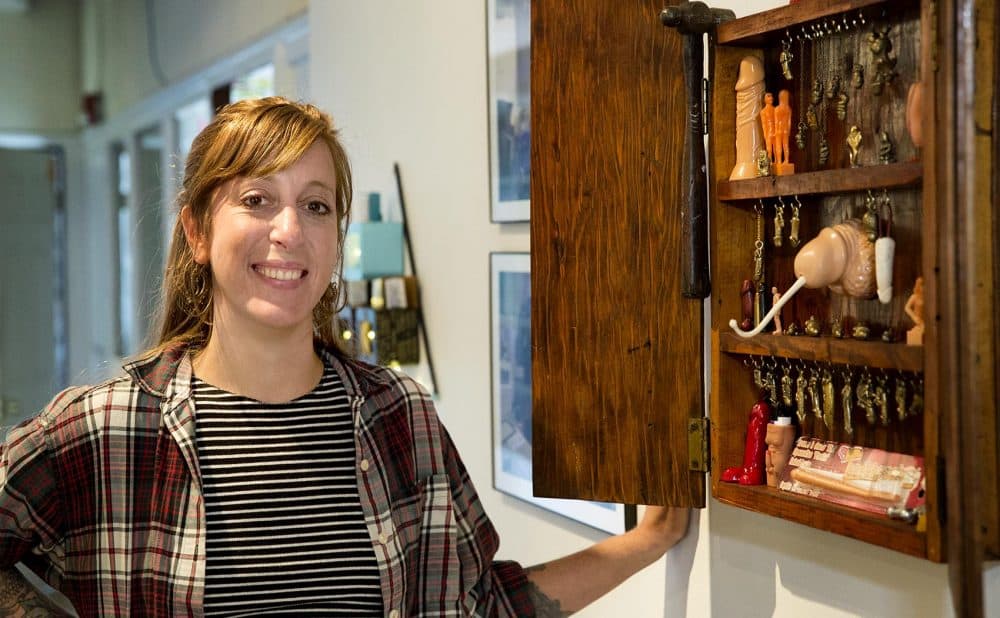
The most “profane” sacred shrine may well be that of artist Rebecca Rose Greene, who has amassed a collection of male genitalia. These include a bottle opener in the form of a penis purchased in the Red Light District of Amsterdam, as well as bawdy 1970s-era plastic figurines doing the nasty bought at an auction for $10, and Palad Khiks, penis amulets believed to offer protection and luck that are commonly worn by men in Thailand.
“My shrine pays homage to man,” she declares. “They are our equals. Strong enough without them, when working together we are unstoppable. This shrine represents the incredible men in my life who have been supportive, encouraging, understanding and kind. To the friends, teachers, partners and lovers who have played a crucial role in my life.”
The divine, it seems, can be found anywhere — even down there.
"Altarations, A Selection of Shrines" at Dorchester Art Project runs July 21 through Aug. 26. The opening reception is on Saturday, July 21 from 6 to 9 p.m. Gallery hours are 12 to 6 p.m., Saturdays and Sundays and by appointment (dorchesterartproject@gmail.com).
